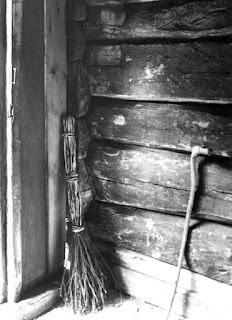The old Norwegian laws and Christian courts had detailed prohibitions against all kinds of witchcraft, and severe punishments were imposed on the accused. Danish-Norwegian legislation maintained this legal tradition both before and after the Reformation. King Christian 2's ecclesiastical law ordered the authorities, especially on Maundy Thursday and Walpurgis Night, to keep an eye on everyone who was suspected of witchcraft. As recently as king Christian 5's Norwegian law of 1687, it is stated that any sorcerer or sorceress who demonstrably "has forsaken God and his holy baptism and Christianity, and devoted himself to the devil, should be thrown alive on the fire and burn."
 |
| 📷 Norwegian Museum of Cultural History |
The oral tradition is naturally far more restrained than the court records in detailing these orgies; it was more concerned with what one could do to protect oneself from the devilry. By placing steel over doors, in beds, barns and stables, a set of safe havens were unsured, keeping the witches at bay. The same was true of crosses, heat and magical formulas as well as the broomstick, the witches' own means of transportation. If the witch did not find a broomstick to ride on, she took a horse or a cow instead, which was much worse. Norwegian sociologist Eilert Sundt thought this was the explanation for the widespread village custom of putting one or more broomsticks outside the kitchen or barn door on Christmas Eve and Maundy Thursday for use by the witches.
The ordinary broomstick was given a very special power of protection, and was used in several ways. Eilert Sundt has pointed out that it was common to put a broomstick in front of the hallway door, so that people could dry their shoes on it before entering the house. Admittedly, spruce bushes and the like could also do the trick, but according the old beliefs it should preferably be a broom; over which neither sorcerers nor any other evil could ascend. According to folklore, the power of broomsticks could also protect people and animals against another side of the witches' activities; their dangerous ability to affect the weather, and provoke gusts and storms. Against such "magic weather", three broomsticks were placed crosswise on a fire, and burned on a Sunday. The magic power in the north wind crumbled when a burning broomstick was thrown into the sea.
Well into the 20th century, the Easter "blow" was a widespread rural tradition in southeastern Norway, basically constituting loose shots fired into the air with pistols and shotguns or gunpowder set on fire. The intention was partly to initiate the holy feast, as the costums were during major church holidays, partly to clean the air of devilry and "shoot the Easter hag". "You shoot on Easter evening to spare the farm from witchcraft. It is this evening that the witches ride from farm to farm broomsticks", it was said in Høland, as late as in 1914. Better remedy for sorcery than gunpowder, bullets and gunshots was yet to be found.
 |
Carl Spitzweg, The witches ride, 1875 |
Sources:
- Hodne, Ørnulf (1988) Påske: tradisjoner omkring en høytid, Grøndahl & Søn Forlag

No comments:
Post a Comment